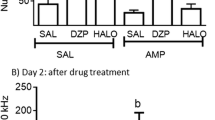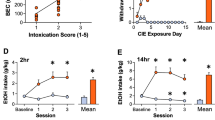Abstract
Ethanol (ETOH), like chlordiazepoxide (CDZ), significantly attenuated the suppressive effect of punishment on licking behavior in water-deprived rats and mice. In rats, the greatest effects of ETOH (1.5 g/kg) were observed between 30 and 60 min following IP administration. tert-Butanol also attenuated the effects of punishment, suggesting that acetaldehyde was not contributing to this effect of ETOH. Since a dose of ETOH that increased punished drinking did not increase unpunished drinking, alteration in thirst motivation would not appear to be responsible for its antipunishment action. However, doses of ETOH or CDZ that significantly increased punished responding increased jump thresholds to aversive shock, suggesting that decreased sensitivity to aversive stimulation may contribute to the anti-punishment action of both agents. In addition to these similarities between ethanol and CDZ, several differences were noted in their effects. For example, CDZ decreased serum corticosterone concentration, whereas ETOH did not. Further, ETOH impaired aerial righting reflex and reduced rectal temperature, whereas CDZ had no effect on these parameters at doses that had anti-punishment activity. Finally, specific binding of [3H]flunitrazepam to crude brain cortical membranes was decreased by CDZ, but not ETOH. Although ETOH and CDZ similarly alter punished behavior, results suggest that ETOH does not act through a direct interaction with a benzodiazepine binding site.
Similar content being viewed by others
References
Barra H III, Miller NE (1965) Comparison of drug effects on approach, avoidance and escape motivation. J Comp Physiol Psychol 59:18–24
Barry H III, Wagner SA, Miller NE (1963) Effects of several drugs on performance in an approach-avoidance conflict. Psychol Rep 12:215–221
Bassett JM, Hinks NT (1969) Microdetermination of corticosteroids in ovine peripheral plasma: effects of venipuncture, corticotrophin, insulin and glucose. J Endocrinol 44:387–403
Boissier J-R, Zebrowska-Lupina I, Simon P (1972) Profile psychopharmacologique du prazepam. Arch Int Pharmacodyn Ther 196:330–334
Bonnet KA, Peterson KE (1975) A modification of the jump-flinch technique for measuring pain sensitivity in rats. Pharmacol Biochem Behav 3:47–55
Braestrup C, Squires RF (1978) Pharmacological characterization of benzodiazepine receptors in the brain. Eur J Pharmacol 48:263–270
Brick J, Sun JY, Davis L, Pohorecky LA (1976) Ethanol and the response to electric shock in rats. Life Sci 18:1293–1298
Cameron EHD, Scarisbrick JJ (1973) The determination of corticosterone concentration in rat plasma by competitive protein binding analysis. J Steroid Biochem 4:577–584
Cappell H, Herman CP (1972) Alcohol and tension reduction: a review. Quart J Stud Alc 33:33–64
Chapin RE, Breese GR, Mueller RA (1980) Possible mechanisms of reduction of plasma luteinizing hormone by ethanol. J Pharmacol Exp Ther 212:6–10
Chin JH, Goldstein DB (1976) Increased membrane fluidity caused by ethanol in spin-labeled mouse erythrocytes. Fed Proc 35:707
Cohen G, Collins M (1970) Alkaloids from catecholamines in adrenal tissue: possible role in alcoholism. Science 167:1749–1751
Conger JJ (1956) Alcoholism: theory, problem and challenge. Reinforcement theory and the dynamics of alcoholism. Q J Stud Alc 17:296–305
Cook L, Davidson AB (1973) Effects of behaviorally active drugs in a conflict-punishment procedure in rats. In: Garattini S, Mussini E, Randall LO (eds) The benzodiazepines. Raven Press, New York, p 327
Eddy CC (1979) The effects of alcohol on anxiety in problem- and non problem-drinking women. Alcoholism: Clinical and Experimental Research 3:107–114
Freed EX (1967) The effect of alcohol upon approach-avoidance conflict in the white rat. Q J Stud Alc 28:236–254
Frye GD, Chapin RB, Vogel RA, Mailman RB, Mueller RA, Breese GR (1980) Central actions of acute and chronic 1,3-butanediol treatment: comparison with ethanol. J Pharmacol Exp Ther (in press)
Geller I, Croy DJ, Ryback RS (1974) Effects of ethanol and sodium phenobarbital on conflict behavior of goldfish (Carassius auratus). Pharmacol Biochem Behav 2:545–548
Glowa JR, Barrett JE (1976) Effects of alcohol on punished and unpunished responding of squirrel monkeys. Pharmacol Biochem Behav 4:169–173
Grossman SP, Miller NE (1961) Control for stimulus-change in the evaluation of alcohol and chlorpromazine as fear-reducing drugs. Psychopharmacologia 2:342–351
Hollander M, Wolfe DA (1973) Nonparametric statistical methods. John Wiley, New York
Leitch GJ, Barkes DJ, Siegman FS, Guthrie GD (1977) Possible role of GABA in the development of tolerance to alcohol. Experientia 33:496–497
Lippa AS, Greenblatt EN, Pelham RW (1977) The use of animal models for delineating the mechanisms of action of anxiolytic agents. In: Hanin I Usdin I (eds) Animal models in psychiatry and neurology. Pergamon Press, Elmsford, New York, p 279
Lippa AS, Klepner CA, Yunger L, Sano MC, Smith WV, Beer B (1978) Relationship between benzodiazepine receptors and experimental anxiety in rats. Pharmacol Biochem Behav 9:853–859
Mailman RB, Ferris RM, Tang FLM, Vogel RA, Kilts CD, Lipton MA, Smith DA, Mueller RA, Breese GR (1980) Erythrosine (Red No. 3) and its nonspecific biochemical actions: what relation to behavioral changes? Science 207:535–537
Malila A (1978) Intoxicating effects of three aliphatic alcohols and barbital on two rat strains genetically selected for their ethanol intake. Pharmacol Biochem Behav 8:197–201
Mansfield JG, Eaton NK, Cunningham CL, Brown JS (1977) Ethanol and approach-avoidance conflict in the rat. Physiol Psychol 5:175–203
Masserman JH, Jacques MG, Nicholson MR (1945) Alcohol as a preventive of experimental neuroses. Q J Stud Alc 6:281–299
Masserman JH, Yum KS (1946) An analysis of the influence of alcohol on experimental neuroses in cats. Psychosom Med 8:36–52
McMillan DE, Leander JD (1975) Drugs and punished responding: effects of drugs on responding suppressed by response-dependent and response-independent electric shock. Arch Int Pharmacodyn Ther 213:22–27
Mello NK, Mendelson JH (1978) Alcohol and human behavior. In: Iversen LL, Iversen SD, Snyder SH (eds) Handbook of psychopharmacology, vol 12. Plenum Press, New York, p 235
Payne DW, Ellis FW (1973) An autoanalyzer II adaptation of an enzymatic determination of blood ethanol concentration. In: Advances in automated analysis. Medical Inc., White Plains, New York, p 169
Sepinwall J, Cook L (1978) Behavioral pharmacology of anti-anxiety drugs. In: Iversen LL, Iversen SD, Snyder SH (eds) Handbook of psychopharmacology, vol 13. Plenum Press, New York, p 345
Sippel HW (1974) The acetaldehyde content in rat brain during ethanol metabolism. J Neurochem 23:451–452
Vogel JR, Beer B, Clody DE (1971) A simple and reliable conflict procedure for testing anti-anxiety agents. Psychopharmacologia 21:1–7
Vogel RA, Frye GD, Wilson JH, Kuhn CM, Mailman RB, Mueller RA, Breese GR (1980) Attenuation of the effect of punishment by thyrotropin-releasing hormone: comparisons with chlordiazepoxide. J Pharmacol Exp Ther 212:153–161
Vogel-Sprot M (1967) Alcohol effects on human behavior under reward and punishment. Psychopharmacologia 11:337–344
Wallgren H, Barry H III (1970) Actions of alcohol. Elsevier Publishing Co., Amsterdam, The Netherlands
Wallgren H, Nikander P, von Boguslawsky P, Linkola J (1974) Effects of ethanol, tert-butanol and clomethiazole on net movements of sodium and potassium in electrically stimulated cerebral tissue. Acta Physiol Scand 91:83–93
Williams RT (1959) Detoxification mechanisms. J. Wiley, New York
Winer BJ (1962) Statistical principles in experimental design. McGraw-Hill, New York
Author information
Authors and Affiliations
Rights and permissions
About this article
Cite this article
Vogel, R.A., Frye, G.D., Wilson, J.H. et al. Attenuation of the effects of punishment by ethanol: Comparisons with chlordiazepoxide. Psychopharmacology 71, 123–129 (1980). https://doi.org/10.1007/BF00434399
Received:
Accepted:
Issue Date:
DOI: https://doi.org/10.1007/BF00434399




